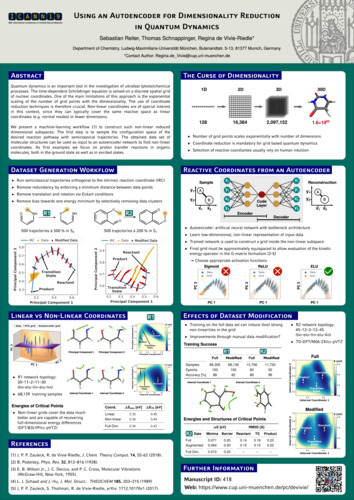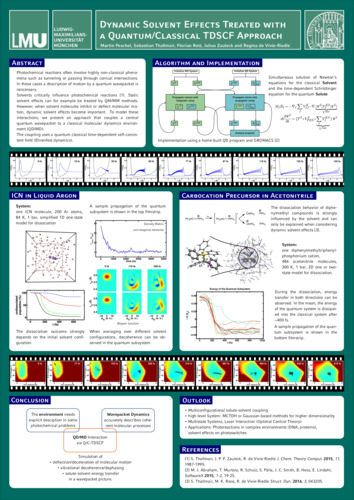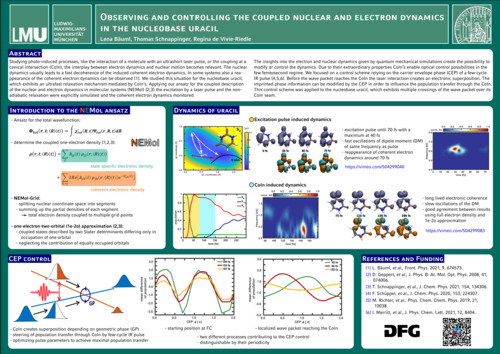Method Development
Propagating the time-dependent Schrödinger equation (TDSE) enables us to investigate ultrafast molecular processes including the interaction with laser fields while fully accounting for the quantum nature of both electrons and nuclei.
Quantum Dynamics in Reactive Coordinates

Using an Autoencoder for Dimensionality Reduction in Quantum Dynamics
ICANN 2019, München
Solving the TDSE for chemically relevant systems is challenging because the computational effort scales exponentially with the number of nuclear coordinates (curse of dimensionality). In practice, this requires careful selection of few, typically 2-3, internal coordinates, which contribute most to the chemical or physical process of interest (e.g. elongation of chemical bonds). To achieve this goal, we develop workflows and tools to perform grid-based wave packet dynamics in reactive coordinates.
Key Publications
- S. Reiter, D. Keefer and R. de Vivie-Riedle
Exact quantum dynamics (wavepackets) in reduced dimensionality
in: Quantum Chemistry and Dynamics of Excited States: Methods and Applications,
L. González and R. Lindh (Eds.), Wiley, 2020, 357-382 (ISBN: 978-1-119-41775-0).
- J. P. P. Zauleck, and R. de Vivie-Riedle
Constructing Grids for Molecular Quantum Dynamics Using an Autoencoder
J. Chem. Theory Comput. 14 (2018), 55-62.
- J. P. P. Zauleck, S. Thallmair, M. Loipersberger, and R. de Vivie-Riedle
Two new methods to generate internal coordinates for molecular wave packet dynamics in reduced dimensions
J. Chem. Theory Comput. 12 (2016), 5698-5708.
- S. Thallmair, M. K. Roos, and R. de Vivie-Riedle
Design of specially adapted reactive coordinates to economically compute potential and kinetic energy operators including geometry relaxation
J. Chem. Phys. 144 (2016), 234104.
- A. Hofmann and R. de Vivie-Riedle
Quantum dynamics of photoexcited cyclohexadiene introducing reactive coordinates
J. Chem. Phys. 112 (2000), 5054-5059.
Multiscale Quantum Dynamics in Complex Environments

Dynamic Solvent Effects Treated with a Quantum Classical TDSCF Approach
WATOC 2017, München
Further increasing the complexity, molecular processes usually take place in solvents or other environments, which can influence the dynamics through steric and electronic interactions. We therefore develop multiscale methods to couple this environmental influence to the dynamics of the target system.
Key Publications
- J. P. P. Zauleck, M. T. Peschel, F. Rott, S. Thallmair, and R. de Vivie-Riedle
Ultrafast Reactive Quantum Dynamics Coupled to Classical Solvent Dynamics Using an Ehrenfest Approach
J. Phys. Chem. A 122 (2018), 2849-2857.
- S. Thallmair, J. P. P. Zauleck, and R. de Vivie-Riedle
Quantum dynamics in an explicit solvent environment:
A photochemical bond cleavage treated with a combined QD/MD approach
J. Chem. Theory Comput. 11 (2015), 1987-1995.
Coupled Nuclear and Electron Dynamics

Observing and Controlling the Coupled Nuclear and Electron Dynamics in the Nucleobase Uracil
Symposium of Theoretical Chemistry 2021, Würzburg
Fully modelling the effects of a laser pulse at sub-femtosecond resolution requires propagating not only a nuclear wave packet on a potential energy surface but also including the motion of the electrons. To achieve this goal, we develop and apply the NEMol ansatz, enabling us to study the temporal evolution of electron density coupled to the nuclear quantum dynamics. This allows us to simulate the control of both electronic and nuclear motion with the help of tailored laser fields.
Key Publications
- L. Bäuml, T. Schnappinger, M. F. Kling, and R. de Vivie-Riedle
Photo-induced coupled nuclear and electron dynamics in the nucleobase uracil
Front. Phys., 9 (2021), 674573.
- T. Schnappinger, and R. de Vivie-Riedle
Coupled nuclear and electron dynamics in the vicinity of a conical intersection
J. Chem. Phys. 154 (2021), 134306.
- H. Li, X. Gong, K. Lin, R. de Vivie-Riedle, X. Tong, J. Wu, and M. F. Kling
Sub-cycle directional control of the dissociative ionization of H2 in tailored femtosecond laser fields
J. Phys. B: At., Mol. Opt. Phys. 50 (2017), 172001.
- D. Geppert, P. von den Hoff and R. de Vivie-Riedle
Electron dynamics in molecules: a new combination of nuclear quantum dynamics and electronic structure theory.
J. Phys. B: At. Mol. Opt. Phys. 41 (2008), 074006.
|

